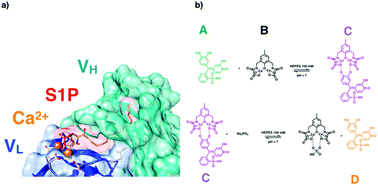A biomimetic cerium-based biosensor for the direct visual detection of phosphate under physiological conditions†
Abstract
An indicator displacement assay (IDA) was used to probe phosphate ions in an aqueous medium at neutral pH using a dinuclear cerium based complex [Ce2(HXTA)]3+. The homoleptic complex can be used to detect phosphate ions with nanomolar affinity either spectrophotometrically or with the naked-eye. To our knowledge, this is the first dinuclear cerium biomimetic IDA detection system with the highest affinity known to date for selective, naked-eye based phosphate recognition under physiological conditions (pH = 5–7) and even in pure water and complex samples such as sea water.



 Please wait while we load your content...
Please wait while we load your content...